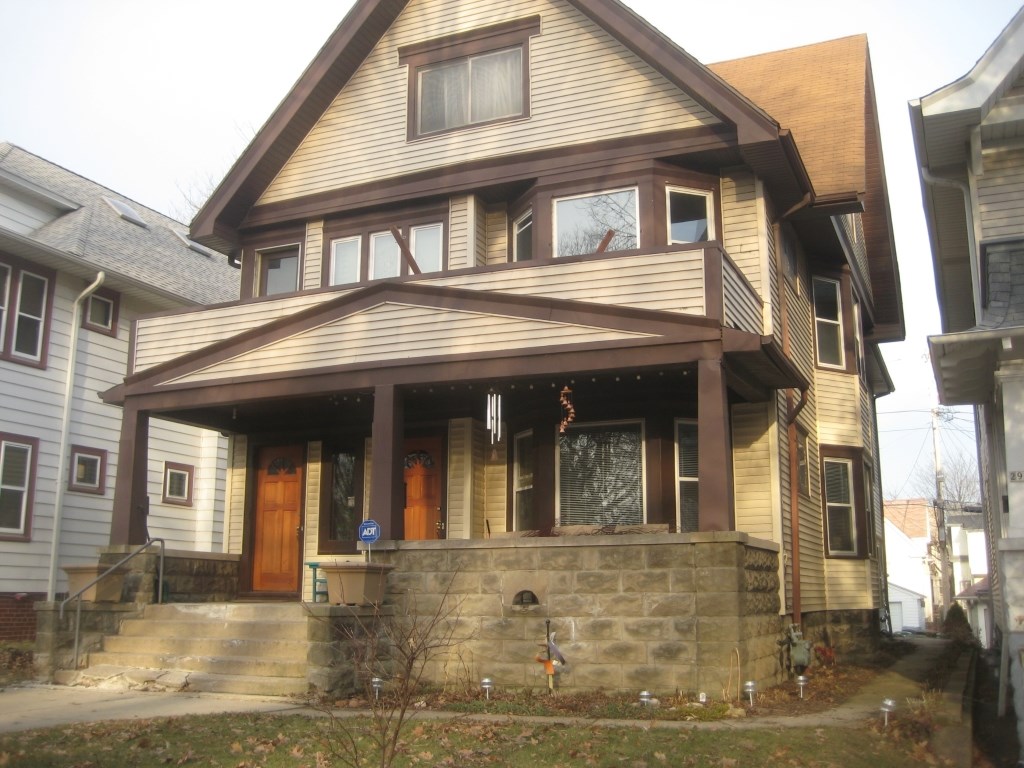Milwaukee, the Land of Duplexes
City is a national leader, which helps explain its surprising strength: density.
When my wife and I bought our first home, it was a duplex, which gave us the advantage of having a rental income to help make the monthly payment. After building up enough equity, we traded the duplex for a single family home. That, I was once told, was “the Milwaukee way,” this being a thrifty town with a lot of duplexes.
A fascinating new analysis by the Washington Post quantifies just how important the duplex is to Milwaukee. It looks at the 40 largest cities (not metro areas) in the U.S. and charts them by the percentage devoted to particular housing styles. In Milwaukee, the chart shows, more than 20 percent of residents live in duplexes, well more than any other city. Chicago is second with probably about 12 percent, but most cities have less than five percent of residents in duplexes.
The chart gives you a quick insight into how cities can vary: New York City, as you’d imagine, leads the way in the percent (nearly half) of residents living in big (more than 20 units) apartment complexes, Baltimore leads in row houses (two single units attached to each other), Boston in complexes of three to four units (like its many New England triple deckers), Mesa, Arizona in mobile homes and RVs (more than 10 percent of the population! — they don’t need transit, they live in it).
It also begins to explain the surprising level of density in Milwaukee. Milwaukee ranks 10th lowest in the percent of residents living in single family homes, at less than 40 percent. In most of the 40 cities, including uber-cool Portland, the majority of residents live in single family dwellings, led by Oklahoma City at an amazing 65 percent of residents.
Not surprisingly, Oklahoma City is anything but compact, with just 956 residents per square mile; that’s less than one sixth the level in Milwaukee, with 6,188 per square mile, as a national analysis of cities by Governing Magazine shows.
Milwaukee’s density is far below the national leader New York City, with 27,012 residents per square mile, San Francisco with 17,179 or Boston with 12,793 residents per square mile. But when you look at the Governing map you’ll see Milwaukee has a higher density than the vast majority of big cities in America.
Take the Midwest. While Chicago (11,842 residents per square mile) and Minneapolis (7,088) are more dense than Milwaukee, every other major city has far less density, from St. Paul (5,484 per square mile) to St. Louis (5,157) to Cincinnati (3,810) to Kansas City (a dismal 1,450 residents per square mile).
In the South, other than crowded Miami (11,136 residents per square mile) every city of any size, including Atlanta (3,154), has far less density than Milwaukee. Likewise in the southwest (the densest Texas city is Houston at 3,502 per square mile), in the west (Denver is at 3,922 per square mile) and on the West Coast, where other than San Francisco, L.A. and Seattle, no city comes close to Milwaukee in density (Portland has just 4,375 per square mile).
In short, the oft-argued idea that Milwaukee lacks the concentrated population of all the cities that have created a streetcar, light rail or the like is simply not true. Milwaukee’s density may help explain why its bus system was long one of the most successful in terms of bang for the buck.
And even this measure of density arguably understates Milwaukee’s potential as a transit-oriented city. The Census Bureau now uses a measure, called population-weighted density, increasingly used by researchers, which takes the measurement down to the census track level and averages that for a city. Using that approach, as my colleague Jeramey Jannene has reported, Milwaukee is far more dense than a city like Seattle, and twice as dense as Portland.
The density of the original city is suggested by an area like Milwaukee’s near South Side, with its remarkably diverse population of Latino, Hmong, African American and older white residents crowded together on blocks with small lots and many duplexes. By contrast, the city’s more spread-out Northwest Side has far less potential for transit.
Because cities like Milwaukee or Philly have more of this older, cheaper housing, they will always be attractive to poor people. And since the surrounding suburbs in Waukesha, Ozaukee, and Washington counties have made sure to avoid building any low-income housing, metro-area poverty is heavily concentrated in Milwaukee. (Yet you will hear representatives of these communities continually blame Milwaukee for not “solving” its poverty problem.)
So density can bring challenges as well as opportunities. But the advantages are substantial. Density lowers the maintenance costs for a city, reducing the per-resident costs of road building and maintenance, water and sewer mains, fire and emergency medical protection and school transportation, as studies like this have found.
Density means more customers per square mile, giving you more restaurants and bars, retail shops and entertainment options, as residents of the Third Ward and Bay View are discovering. It’s how great cities are created, the kind that attract tourists world-wide.
As cities achieve higher density, you get more people walking, using public transit, bicycling and spending less time commuting. People’s health improves because they are walking more and exposed to fewer harmful emissions from cars.
Whatever the pros and cons of urban density, the reality is that Milwaukee needs to be a part of the increasingly important conversation about it. For this is a city with greater density than most in America, and local policymakers (and state legislators periodically overruling local control) should keep that in mind, because the decisions they make can improve the city and save taxpayers money simply by helping maximize compact development and an urban lifestyle.
Murphy's Law
-
Is Legislature Biased Against Working Class?
 Apr 4th, 2024 by Bruce Murphy
Apr 4th, 2024 by Bruce Murphy
-
Associated Press Will Decline in Wisconsin
 Mar 27th, 2024 by Bruce Murphy
Mar 27th, 2024 by Bruce Murphy
-
City Attorney Race Is Vitally Important
 Mar 25th, 2024 by Bruce Murphy
Mar 25th, 2024 by Bruce Murphy


















Density is good for business, its no surprise that some of the densest neighborhoods of the city are often those that are thriving.
And we need to find a way to really up the density. I wish the city would go rogue on the state and just drop all parking requirements and approve the densest of dense development along all major arterial. I’m looking at you, S. 1st Street! Those parking lots needs to go!
@Beer Baron City imposed parking requirements isn’t the biggest parking issue in Milwaukee. The real problem is banks, developers, and well NIMBYs. Many banks still won’t lend without x number of parking spots per bedroom. Developers continue to build more parking than ‘required’. And then there is the NIMBYs, that fight density and push developers to include more parking. Now of course the streetcar will help in pushing developers to build less parking (just one of its benefits).
With this in mind you might want to know what is the density required for a streetcar to be successful. Forgetting for a moment the argument that street cars increase density, which has yet to be proven.
How much density supports a street car?
I not sure when, maybe as late as the 1930’s, Milwaukee had the same density at San Fransisco does today (around 16,000/square mile), and we had a viable streetcar.
Milwaukee’s density compared to many other Midwest cities is something to be celebrated, and some more density would be welcomed — to a point. Believe it or not, there are people who want to live in an urban environment without the crush of people that you get in a NYC, SF, or Chicago. The fact Milwaukee has more breathing room than a place like Chicago to some extent reflects lagging economic development, but it is also an asset in itself. As the data on Portland would suggest, high density is not essential to making a city an attractive destination, whether for workers or global tourists.
In 1920 Milwaukee was the densest city 2nd only to NYC at 18,069/sq mile.
https://www.census.gov/population/www/documentation/twps0027/tab15.txt
When you look at the city limits of the 20’s and 30’s that’s were we the neighborhoods with some of the most potential. Mixed use buildings, duplexes and bungalows allows for different classes of people all live relatively close to each other and when the small local business fill in the vacant store fronts then the need for a car (or at least multiple cars) really diminishes.
Bruce (or others) – I’d love to know if anyone has ever measured residential population density as population per square-mile of zoned residential area. That would seem to be a more accurate measure than based on total square mileage. Consider that the Port of Milwaukee and GMIA are within the Milwaukee city limits. While Minneapolis is supposedly more dense than Milwaukee, that city doesn’t absorb the acreage of the MSP airport or a major Great Lakes port.
I’ve never really thought of Milwaukee as “dense”, with the exception of certain parts of the Eastside. Duplexes are obviously more dense than single family housing but pale in comparison to apartment buildings. The comparison to many of the other cities is actually surprising.
It’s been interesting watching the community reaction in Bay View to the proposed developments. While many people champion density, especially businesses, there appears to be a large number of people who equate density with more crime and problems for the neighborhood. Thankfully those people haven’t stopped all development in the area. I suspect that they are simply more vocal than those who are neutral or supporters of such development in the neighborhood.
To be honest, and this is mostly a reply to BPI, I have no sympathy for individuals who fight against density in urban environments. If you like to live in/near an urban area but don’t like density, then you should be living in a near suburb like West Allis or Cudahy unless you can afford Northpoint or places like Washington Blvd. in Washington Heights. If you live in a city neighborhood you should accept what that entails rather than trying to fight growth. I’m sorry you’ll have to walk an extra few feet to your car, or that you’ll have to actually use your garage for a vehicle rather than storage. I’m sorry that your street may not be dead silent and pitch black at night, or that you may have to spend an extra couple of minutes in the morning in surface street traffic. Suburban expectations simply can’t coexist with dense urban environments as they continue to grow. Density does not mean there won’t be open spaces, parks, and breathing room. It, however, does mean that housing parcels will be put to their most efficient use, and that use involves more than one or two households occupying a lot.
Much of Milwaukee’s density was due to three-family narrow lots. This was particularly true on the north side. The original German immigrants, when they had the cash, bought a narrow lot and built a single family cottage. They had big families and one of the offspring, often the oldest son, married, then moved Mama and Papa’s house to the rear of the lot on the alley, built a big duplex and rented out the upper flat: Result, Milwaukee was most densely populated city of the north, with three families, often big families, on a single lot. It support mass transit, first trolleys and then curbliners, into the 1960s, when post-war prosperity, universal automobile use and the desire of the returning GIs for open space cause the suburbs to sprawl. The southside had even narrower lots with Polish flats, maintaining the density per square mile.
I believe contrary to popular belief the eastside isn’t the densest part of town but its actually the southside around Kozy park. Census tracts in that neighborhood or in the low 20k/sq mile. The near south side really could make great use of a streetcar if we’re justifying it by a neighborhoods density.
As Casey pointed out (he beat me to it), Milwaukee for a good two-three decades was second only to NYC for density (and roughly the same ranking in foreign-born). Besides smaller families and annexation of wide-open spaces by the city, raising the number of single family homes, we lost about 200,000 between 1960 and roughly 1990 to a combination of white flight and upward mobility (the move to the suburbs either way). Like almost all American cities we’ve stabilized and reversed that out-population trend. Then there’s micro-phenomena — my wife and I bought the two drug houses next door (just the real estate, not the business), worker cottages front and back. There was originally a third house on the narrow lot. Next to that is one house on a lot where there had been two, the back one long gone. Just on one block four or five back houses have been torn down over the years. Repeat that story for several blocks around, but you can’t tell from the street.
LOve duplexes, lived in one on Franklin and Jackson during 9 of my 10 years in town. Nice investment, too. anyhow, Bruce, no postscript on Chance the gardener? NOw he knows what Mary BUrke felt like to walk the lunar surface without a helmet. With roots severed, I wonder how all is, and how all will be, in the garden.
The density in Milwaukee is what makes it like a ‘real’ city. You can go home, park your car, and walk down the block, get a newspaper, coffee, whatever, and walk around. You have, similar to Chicago, stores and services almost at the intersection of where all major streets meet. Downer Avenue, Oakland and Capitol, North and Farwell, Bay View, 13th and Oklahoma, North Avenue from the lake all the way to 92nd, and more. I moved to Indianapolis for work and as a city, it’s a joke. They have one neighborhood shopping area of the city (Broad Ripple), that’s four blocks long, that they keep touting as a ‘real’ neighborhood. The rest of the place looks like far Brookfield: sad, 80’s built, bad two story apartment complexes you have to drive around in to find your place, and nothing walkable! It really makes you realize how much the architecture contributes to the sociology! I could never spend the rest of my life in Indianapolis, I certainly could in Milwaukee, if I could find a job there…
Some of Milwaukee’s high density resulted from building housing close to major employers. Workers has to walk or take transit before everyone had cars. That balance has shifted over the decades, first with residents fleeing to the suburbs and then with manufacturers pulling up roots. More businesses–and residents–are returning to the city, at least in some areas. But it’s still a big hassle for many to get to jobs without a car.
A quick glance at 2010 Census figures appears to show that there were four census tracts in the city with a population density of 25,000/sq mi – two near Marquette (Tract 146 – 25,300; Tract 147 – 31,600), one roughly centered on 13th & Greenfield (Tract 164 – 27,500), and one roughly centered on Humboldt & Ogden (Tract 11 – 31,900).
There were many others in the 15,000 to 25,000 range as well.
@DTY – Population-weighted density takes this into account (by not weighting the land with no or very few residents). Milwaukee is more dense by this metric.
@Thomas Bamberger:
Milwaukee has long had enough density to support quality transit. The reason a streetcar won’t drive ridership is the same reason that the original streetcars failed— once the streets filled with auto traffic, streetcars got stuck in traffic jams.
To compete effectively with cars, rail transit (and bus transit, for that matter) needs an exclusive right-of-way. Fortunately, between the rail-trails and boulevard medians, Milwaukee has many candidate routes where it would be trivial to set up high-quality light rail, many with preexisting dense transit-oriented-development from the streetcar era.
For example, the transit agency would need to do essentially no property condemnation to run a grade-separated light-rail line along the Oak Leaf Trail in the east side, curving over to Wisconsin Avenue downtown where it could run in an exclusive median to Hawley Road, where it could rejoin the old streetcar right-of-way next to the railroad along State Street to the Village in Wauwatosa, and from there through the County Grounds to the office parks there or to Mayfair Mall.
Such a route would connect some of the densest residential neighborhoods and biggest employers, and would be very simple to implement, requiring no takings of land, and hardly even any traffic lanes or parking spaces.
Going further to Waukesha would be a lost cause. But, frankly, Milwaukee doesn’t need Waukesha.
Tom Bamberger is correct about the advantages of exclusive right-of-way for rail transit. In fact the route he suggested was the exact route selected back in 1996 as the light rail locally preferred alternative. The projected capital cost was $444 Million in 1996 dollars (about $900 Million in today’s dollars). Governor Tommy Thompson killed this project in 1997. If we had $900 Million today, I would be a strong advocate of the route he suggested. However, we have only $54 Million in federal funds today, not the $489 Million in federal funds we had available in 1996.
So the city designed a starter streetcar route that we could afford with the funds available. It was either this option or forfeit the federal funds again.
Hey WAUKESHA!!! Did you hear that, “ALAN” says MKE doesn’t need you, so go stuff it!!! Actually, in many ways, “ALAN” is right, we don’t need things like the Waukesha cops, (and NO I’m not one of the herd of sheep jumping on the “cops are awful” bandwagon this year-BUT) the Waukesha cops who when they see a “major crime in progress” which in Waukesha apparently includes operating a motor vehicle late at night and I don’t mean swerving all over the road with the reek of booze pouring out of the windows, I simply mean any law abiding citizen who dares to take their car out late at night, expect the full “Gestapo treatment” from the WPD, you know like getting followed for miles, once pulled over supposedly knicking the center line, then having like 4 more squads pull up, full stupid light show going the whole time, etc and then for the cops to be visibly PISSED when you blow a .000 into their little magic breath machine and maybe it is true that you really weren’t just out getting bombed at one of Waukesha’s MANY happenin’ night spots!
One thing though “ALAN”, Milwaukee does NEED Waukesha (and the rest of those awful burbs with their disgusting urban sprawl (said with a real sneer!)) MKE NEEDS THEIR $$$$$$$$$$$!!!!!!!!!! Who pays for all of this free crap we hand out to those who choose not to support themselves and their legions of offspring???!!!! Sure, some of those fancy condos downtown and in the 3rd Ward have helped, even if its really more of a national trend and just wait till that STREETCAR gets here, with its ugly ass overhead power wires they always just somehow forget to put in the many “renderings”! Oh boy, once biz owners hear that magic STREETCAR word, EVERYONE will want to rent space!!
Then, it will be just like it is now in Bay View, where a bunch of whiny losers will show up for EVERY single development meeting to fight ANY new development of the STREETCAR MONEY TREE, since it also raises rents and just like the clowns in Bay View who want “hip and trendy” PLUS same rent as they paid back in ’79, the fight will rage!!!
@BT Milwaukee only receives 92 cents back from the capitol for every dollar sent there.
That is one tires old argument that MKE doesnt pay for itself.
In 1947, Milwaukee reached its peak density with almost 600,000 residents crammed into 44 square miles. Some neighborhoods (Avenues West, 20th and Walnut, among others) had densities of over 20,000 per square mile. Lenient zoning (“negative-zoning”, as it was labelled) only stated prohibited activities (stinky, loud, or otherwise objectionable), while passively encouraging creative, efficient land use. This zoning was replaced with”positive” zoning which lists specifically what is allowed (any exceptions get sent to BOZA). Dollar General would have NO problem opening the King/North store in 1915, whereas in 2015 they are pilloried. The twisting of labels, with “negative zoning” being lenient and “positive zoning” being increasingly restrictive, is Orwellian. The resulting City zoning codes became Kafka-esque.
Stephen, I see you’re upset with the current system of zoning codes but what can the city of Milwaukee do to change that now?
http://cityobservatory.org/the-prisoners-dilemma-of-local-only-planning/
“If both neighborhoods choose “inclusionary” policies, they’ll each become mixed-income, but mostly middle-class, communities. But if only one chooses “inclusionary” policies and the other chooses “exclusionary,” the “inclusionary” community will become disproportionately low-income, because it’s the only attractive, welcoming place for people who need affordable housing and social services.”
Looks like Milwaukee is already on the losing end of this… what’s your solution?